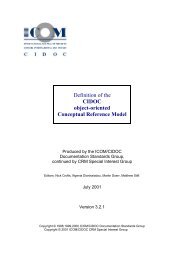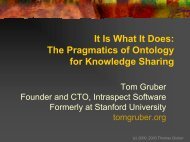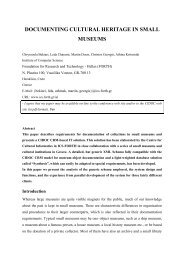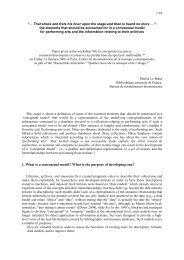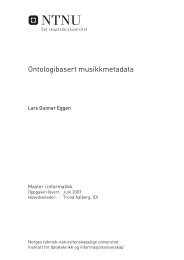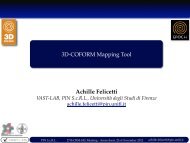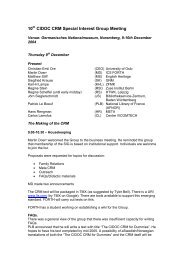pdf file - The CIDOC CRM
pdf file - The CIDOC CRM
pdf file - The CIDOC CRM
You also want an ePaper? Increase the reach of your titles
YUMPU automatically turns print PDFs into web optimized ePapers that Google loves.
Properties:<br />
E5 Event<br />
Subclass of:<br />
Superclass of:<br />
Scope note:<br />
Examples:<br />
Properties:<br />
• Cubism<br />
P7 took place at (witnessed): E53 Place<br />
P8 took place on or within (witnessed): E19 Physical Object<br />
P9 consists of (forms part of): E4 Period<br />
P10 falls within (contains): E4 Period<br />
P132 overlaps with: E4 Period<br />
P133 is separated from: E4 Period<br />
E4 Period<br />
E7 Activity<br />
E63 Beginning of Existence<br />
E64 End of Existence<br />
This class comprises changes of states in cultural, social or physical systems, regardless of<br />
scale, brought about by a series or group of coherent physical, cultural, technological or legal<br />
phenomena. Such changes of state will affect instances of E77 Persistent Item or its subclasses.<br />
<strong>The</strong> distinction between an E5 Event and an E4 Period is partly a question of the scale of<br />
observation. Viewed at a coarse level of detail, an E5 Event is an ‘instantaneous’ change of<br />
state. At a fine level, the E5 Event can be analysed into its component phenomena within a<br />
space and time frame, and as such can be seen as an E4 Period. <strong>The</strong> reverse is not necessarily<br />
the case: not all instances of E4 Period give rise to a noteworthy change of state.<br />
• the birth of Cleopatra (E67)<br />
• the destruction of Herculaneum by volcanic eruption in 79 AD (E6)<br />
• World War II (E7)<br />
• the Battle of Stalingrad (E7)<br />
• the Yalta Conference (E7)<br />
• my birthday celebration 28-6-1995 (E7)<br />
• the falling of a tile from my roof last Sunday<br />
• the <strong>CIDOC</strong> Conference 2003 (E7)<br />
P11 had participant (participated in): E39 Actor<br />
P12 occurred in the presence of (was present at): E77 Persistent Item<br />
E6 Destruction<br />
Subclass of: E64 End of Existence<br />
Scope note:<br />
This class comprises events that destroy one or more instances of E18 Physical Thing such that<br />
they lose their identity as the subjects of documentation.<br />
Some destruction events are intentional, while others are independent of human activity.<br />
Intentional destruction may be documented by classifying the event as both an E6 Destruction<br />
and E7 Activity.<br />
Examples:<br />
<strong>The</strong> decision to document an object as destroyed, transformed or modified is context sensitive:<br />
1. If the matter remaining from the destruction is not documented, the event is modelled solely<br />
as E6 Destruction.<br />
2. An event should also be documented using E81 Transformation if it results in the<br />
destruction of one or more objects and the simultaneous production of others using parts or<br />
material from the original. In this case, the new items have separate identities. Matter is<br />
preserved, but identity is not.<br />
3. When the initial identity of the changed instance of E18 Physical Thing is preserved, the<br />
event should be documented as E11 Modification.<br />
• the destruction of Herculaneum by volcanic eruption in 79 AD<br />
• the destruction of Nineveh (E6, E7)<br />
Definition of the <strong>CIDOC</strong> Conceptual Reference Model 4



